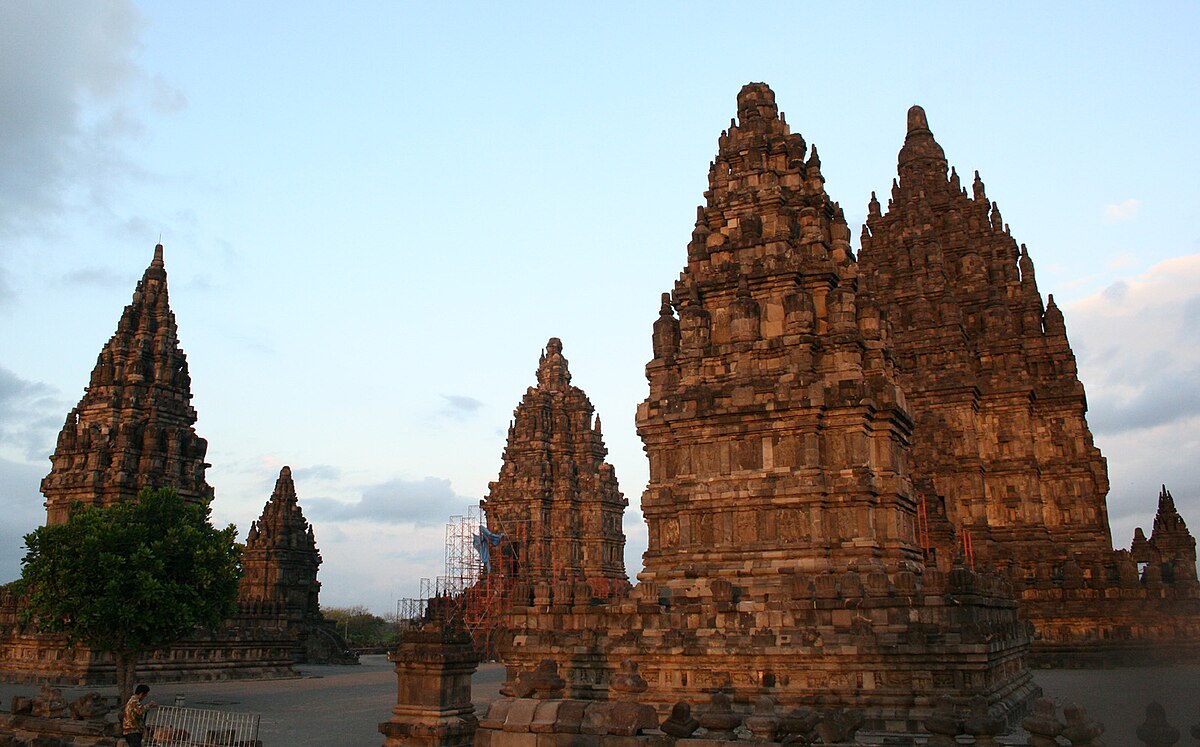
This research was funded by ASEA-UNINET, Project ASEA 2023-2024 /Uni Wien/6.
A comparison between the Gedhe Kauman Mosque and another mosque from the same time demonstrates a hierarchical structure of musque architecture in Yogyakarta:
„The roof of the main building of the Plosokuning Mosque is in the form of a two overlapping tajug. The use of the two overlapping tajug roofs is intended in order to the Plosokuning Mosque does not forget the unique characteristics of the building, which is an imitation of the Gedhe Kauman Mosque, which means it belongs to the Ngayogyakarta Hadiningrat Palace.
However, there is a difference in the number of overlapping tajug roofs between the Sultanate mosque (Kauman Great Mosque) and the Plosokuning Mosque, namely that the Great Kauman Mosque has three tajug roofs (three levels) while the Plosokuning Mosque has two overlapping tajug roofs.
In Javanese cosmology, which places the kraton as the center of the cosmos, the difference in the number of overlaps is to show that the position of the Plosokuning Mosque is hierarchically lower than the Great Mosque of Kauman.“ (Fauzi 2020: 15-16)
Older mosques than the Gedhe Kauman Mosque are still available in Yogyakarta:
„Mosque Gedhe Mataram Mosque is the oldest mosque in Yogyakarta. Located in the south of the Kotagede Market area now, to be precise in Jagalan village, Banguntapan sub-district, Bantul. Kotagede Mosque was built during the Mataram Kingdom era in 1640 by Sultan Agung together with local people who are generally Hindu and Buddhist. This mosque has an inscription which states that the mosque was built in two stages. The first stage was built during the Sultan Agung era only in the form of the core building of the mosque which was small so that it was called langgar. The second stage of the mosque was built by the King of Kasunanan Surakarta, Paku Buwono X. The different parts of the mosque built by the Sultan Agung and Paku Buwono X are on the pillars. The part that was built by Sultan Agung had wooden poles while those that were built by Paku Buwono had iron poles. This mosque is still alive today. Residents still use it as a place to carry out religious activities. This mosque building is a form of tolerance by Sultan Agung when the residents who participated in building the mosque embraced Hinduism and Buddhism. Hindu and Buddhist characteristics still clearly influence the building of this mosque […] The core building of the mosque is a Javanese pyramid-shaped building, its characteristics can be seen on the pyramid-shaped roof and the room which is divided into two, namely the core and the foyer.“ (Purbahanggita/Prianto 2021: 300-301)
Again, this is a Sultan’s mosque. For an adequate idea of the mosque topography in Yogyakarta we will have to look beyond the Sultan’s great mosque and similar places as Aryanti proposes to
„consider the perspective of the actual members of the community—in this case the community in Yogykarta, Indonesia–in addition to the authoritative perspective that has typically been privileged in the existing scholarship on mosque architecture, while regarding buildings as part of an integrated contemporary social, cultural, and political system.“ (Aryanti 2013: 7)
Other Mosquees
The political aspect of the religious topography, esp., the mosque topography, is evident when turning to the Masjid Syuhada, a mosque established in commemoration of the victims of the fight against the Japanese in Yogyakarta in October 1945 CE. The mosque was officially opened in 1952 CE. It was regarded as a symbol of victorious Indonesian nationalism in the former colonial, white neighborhood of Kotabaru, a symbol for colonialism.
„Compared to other mosques in Indonesia in the 1950s, the Syuhada Mosque was perhaps the most modern in terms of facilities. In addition to a partition of prayer halls between men and women, a special room was allocated for women on the ground floor as a changing/makeup room. This was a breakthrough, given that the majority of Muslims saw the mosque as a male territory,interpeting one of the Prophet Muhammad’s words which state that women are better performing prayer at home. Syuhada, therefore, asserted that it welcomed women and recognized one of women’s major needs: makeup. Indeed, it was partly for this reason that some Muslim women came to Syuhada. Meanwhile, the toilet and bathroom were made of good quality materials and were carefullymaintained. Sandals were no longer spread in the frontyard, but were put on racks […]. There was also a hall which was used as a lecture room; at that time, Syuhada Mosque was famous because of this room […]. Of no less importance, Syuhada had a library. Other facilities were a loud speaker and a telephone. A small studio was built inside the mosque, through which sermons were broadcast by radio all over the city […]. The mosque also had an electronic device to record the sermons […]. When it was officially opened, Syuhada’s floor was covered by a beautiful and expensive carpet, which was donated by the Pakistani Embassy in Jakarta […].“ (Zara 2016: 17)
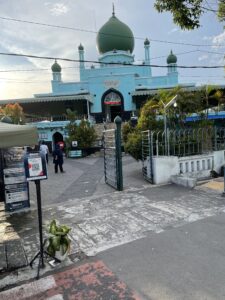
Masjid Syuhada (February 2024, by the author)
Another interesting mosque in Yogyakarta is the campus mosque of Universitas Gadjah Mada. It was inaugurated in 1999. The architecture is a blend of the Prophet’s Mosque in Medina, Chinese, Indian, and Javanese architectural styles; the pool in the courtyard is said to be inspired by the one of Taj Mahal. The capacity of visitors is 10,000.
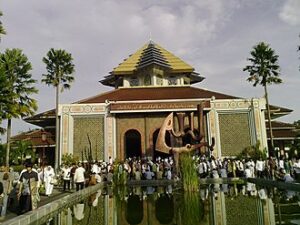
Masjid Kampus UGM[2]
Also in the district of Sleman another example of a modern mosque is the Suciati Mosque.
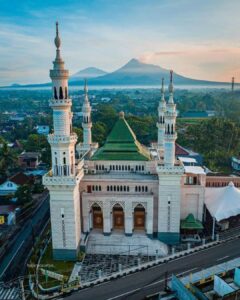
Suciati Saliman Mosque[3]
After the opening in 2018 this mosque became a popular space with a capacity up to 1.500 worshippers.
„The most striking characteristic of this mosque is in the architecture that resembles the Prophet’s Mosque. This can be seen from each side of the mosque which has its own philosophical value. The five towering minarets represent the number of Muslim prayer times. The nine main doors describe the number of saints who spread the teachings of Islam in the archipelago known as Wali Songo. The dome of the mosque in the form of a typical Javanese joglo illustrates harmonious cultural acculturation.“ (Nurjannah/Wuladari/Rohmah 2024 : 1070)
The Jogokariyan Mosque[4] illustrates the type of community-centered mosques. Its name is derived from the kampong it was built in not bearing an Arabic style name.
„Besides the main room of the mosque and a three-star-hotel-like inn, this mosque is also equipped with a multipurpose room or an auditorium that can accommodate around 200 people. One of Jogokariyan Mosque’s phenomena is that it has 21 bathrooms that can be used by the congregators to clean up, take a bath and take wudlu (ablution). These bathrooms are always well-maintained, clean and open for public, just like the mosque open for public for 24 hours a day. We often notice that in many mosques, the bathrooms are insufficient, dirty, and poorly maintained.
Jogokariyan mosque’s logo is inscribed in three alphabets. First, it is inscribed in Javanese alphabet at the top, symbolizing the local culture of Jogokariyan residents whose mother tongue is Javanese. Second, it is inscribed in Arabic, implying that Islam is inseparable from Arabic language, that must be learned by every Muslim including the Muslims residing in Jogokariyan Kampong. […] Third, it is inscribed in Latin alphabet just like Indonesian language is inscribed in Latin alphabet, which means that Jogokariyan residents are nationalists. It is inscribed Masjid Jogokariyan Yogyakarta 1966. […] The year 1966 shows that the mosque was built in that year.“ (Letmiros 2020: 518)
Less prestigious are prayer rooms (Arab. Musallā, Indon. musholla). Although there are many we restrict ourselves to two examples:

Prayer room at private property, JL Jend. Sudirman (February 2024, by the author)
Another prayer room – similar to facilities at other international airports – can be found at the Yogyakarta airport:
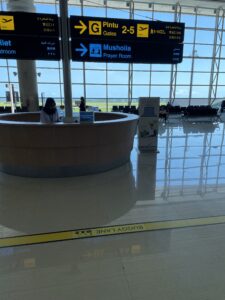
Airport Yogyakarta (February 2024, by the author)
This overview may provide an idea of the mosque topography of Yogyakarta. Some
Other religious sites
There are some churches present in Yogyakarta. As it is the case with some mosques these churches are not as prominent as in a pre-dominantly Christian environment. Two examples may help to get a better understanding. The first example is a Catholic church (in renovation in 2024 CE). The roofs are inspired by Javanese architectural styles.

St. Antonius of Kotabaru (February 2024, by the author)
Protestant churches may be even less prominent. They, e. g., blend into the built environment of the prominent Malioboro Street:
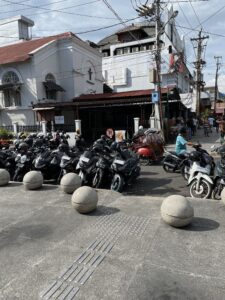
Protestant Church, Malioboro Street (February 2024, by the authot)
A unique part of the religious topography is the Chinese temple of Klenteng Poncowinatan offering an opportunity to follow Confucian, Taoist, and Buddhist traditions. The architecture of the site shows some Javanese influences. Thus the klenteng symbolizes the cross-cultural and intercultural dimensions of the city of Yogyakarta. The temple was established in 1881 and was in a difficult situation due to the persecution of Chines after 1965 CE. Each „klenteng has places to worship deities and holy figures associated with Confucianism, Daoism, and Buddhism, as well as local religions.“ (Tuhri 2017)[5] The local religious dimension is evident when looking at the acculturation of Chinese and Javanese cultural elements during the Chinese New Year (Pramadiusni 2021).
Conclusion
Looking at the religious topography of Yogyakarta, both the city and region, several characteristics of its spatial constellation are notable. The most important trait is the persistence of pre-islamic traditions we may call Javanese. The non-Islamic traditions like Buddhism and Confucianism may influence each other and are influence by Javanese local religious traditions. Even Christian churches show some aspects of Indonesian architectural traditions.
Islamic traditions are on the one hand influenced by local Javanese traditions, Hinduism, and Buddhism, on the other hand by transnational Islamic traditions. Architecturally speaking, the religious space of the region of Yogyakarta is a hybrid space intersecting with several religious traditions.
[1] By Aisha Tanduk, CC BY-SA 4.0 <https://creativecommons.org/licenses/by-sa/4.0>, via Wikimedia Commons.
[2] [[File:After ied fitri praying @ UGM mosque Yogya – panoramio.jpg|thumb|After ied fitri praying @ UGM mosque Yogya – panoramio]]
[3] https://www.maioloo.com/tips-guides/largest-mosques-in-yogyakarta/ (last accessed February 23, 2025)
[4] https://masjidjogokariyan.com/ (last accessed February 23, 2025)
[5] For Buddhist influence on Confucianism cf. Buaban 2021. For the identities of Chinese Buddhists in Indonesia cf. Suprajitno 2019.
References:
Tutin Aryanti, Breaking the Wall, Preserving the Barrier: Gender, Space, and Power in Contemporary Mosque Architecture in Yogyakarta, Indonesia, Diss. Phil., Urbana, Ill.: University of Illinois at Urbana-Champaign, 2013
Balai Konservasi Borobudur, 100 Tahun Pascapemugaran Candi Borobudur. Trilogi I: Menyelamatkan Kembali Candi Borobudur, Magelang: s. p. s. d.
Balai Konservasi Borobudur, 100 Tahun Pascapemugaran Candi Borobudur. Trilogi II: Dekonstruksi dan Rekonstruksi Candi Borobudur, Magelang: s. p., 2012
Balai Konservasi Borobudur, 100 Tahun Pascapemugaran Candi Borobudur. Trilogi III: Candi Borobudur dalam Multiaspek, Magelang: s. p. s. d.
Timothy E. Behrend, „Kraton and Cosmos in Traditional Java,“ in Archipel Villes d’Insulinde (II) 37, 1989, pp. 173-187
Adam Bobette, The Pulse of the Earth: Political Geology in Java, Durham: Duke University Press, 2023
Jesada Buaban, „Compassionate Goddess and Filial Monk: The Influence of Confucian Values on Chinese Buddhism and Its Practices in Indonesia,“ in Antropologi Indonesia 42ii, 2021, pp. 114-124
Peter Cirtek, Borobudur: Entstehung eines Universums, Hamburg: Monsun Verlag, 2016
Mike Davis, Planet der Slums, Berlin: Assoziation A, 2007
Jaques Dumarçay, Borobudur, Oxford et al.: Oxford University Press, 1986
Fahrur Fauzi, Misnal Munir & Rizal Mustansyir, „Symbolism in the aesthetics architectural of Plosokuning mosque Yogyakarta,“ in Research, Society and Development 9xi, 2020, pp. 1-20
Julie A. Gifford, Buddhist Practice and Visual Culture: The visual rhetoric of Borobudur, Abingdon/New York, 2011
Muhamad Idris & Jeki Sepriady (eds.), Mutiara Borobudur: Tafsir Bodhi Citta, Kajian Sejarah dan Ikonografi, Palembang: CV. Insan Cendekia Palembang, 2017
Asyifa Nadia Jasmine, Mohamad Jusuf & Irwan Abdullah, „Eksistensi dan Koeksistensi Budaya Tionghoa dalam Masyarakat Jawa Yogyakarta,“ in Al Izzah: Jurnal Hasil-Hasil Penelitian 18i, 2023, pp. 15-30
Roy E. Jordaan, „Sītā as Rāvaṇa’s Daughter at Candi Prambanan,“ in Andrea Acri & Peter Sharrock (eds.), The Creative South: Buddhist and Hindu Art in Mediaeval Maritime Asia, Volume 2, Singapore: ISEAS–Yusof Ishak Institute, 2022, pp. 145-167
Hudaya Kandahjaya, „The Scheme of Borobudur,“ in Andrea Acri & Peter Sharrock (eds.), The Creative South: Buddhist and Hindu Art in Mediaeval Maritime Asia, Volume 2, Singapore: ISEAS–Yusof Ishak Institute, 2022, pp. 55-73
Hudaya Kandahjaya, A Study on the Origin and Significance of Borobudur, Diss. Berkeley, 2004
Sitti Attari Khairunnisa, Taufiq Hidayat, Wayne Orchiston & Nok Nikeu, „Astronomical Aspects of the Prambanan Temple in Central Java, Indonesia,“ in Wayne Orchiston & Mayank N. Vahia (eds.), Exploring the of Southeast Asian Astronomy: A Review of Current Projects and Future Prospects and Possibilities, Cham: Springer Nature, 2021,pp. 487-502
Letmiros Letmiros, „Jogokariyan Mosque in Yogyakarta: as a Legendary and Phenomenal Agent of Change,“ in International Review of Humanities Study 5ii, 2020, pp. 511-523
metroZones (ed.), Faith is the Place: the Urban Culture of Global Players, pp. 6-17, Berlin: b_books, 2012
Destario Metusala, Fauziah, Dewi Ayu Lestari, Janis Damaiyani, Shofiyatul Mas’udah & Hari Setmayan, „The identification of plant reliefs in the Lalitavistara story of Borobudur temple, Central Java, Indonesia,“ in Biodiversitas 21v, 2020, pp. 2206-2215
Umakanta Mishra, „Circulation of Buddhist Maṇḍalas in Maritime Asia: Epigraphic and Iconographic Evidence from Odisha and Java (8th–11th century),“ in Andrea Acri & Peter Sharrock (eds.), The Creative South: Buddhist and Hindu Art in Mediaeval Maritime Asia, Volume 2, Singapore: ISEAS–Yusof Ishak Institute, 2022, pp. 27-51
Masanori Nagaoka, Cultural Landscape Management at Borobudur, Indonesia, Cham: Springer Nature, 2016
Mauliya Redyan Nurjannah, Dewi Eka Wulandari & Latifur Rohmah, „Revitalization of mosque functions in society empowerment (Case study of Suciati Saliman Mosque, Yogyakarta),“ in Proceeding of International Conference on Accounting & Finance, Vol. 2, 2024, pp. 1066-1075
Henky Hotma Parlindungan, Tatan Sukwika & Hendra Manurung, „Prambanan Temple Tourist Destination Development in Indonesia as World Cultural Heritage,“ in Eureopean Journal of Science, Innovation and Technology 1iii, 2021, pp. 39-56
Diwa Inggit Pramahdiusni, Akulturasi Budaya: Tradisi Tumpeng dalam Perayaan Tahun Baru
Imlek di Klenteng Poncowinatan Yogyakarta, Diss. Phil UIN Sunan Kalijaga Yogyakarta, 2021
Fahmi Prihantoro, Irham Wibowo, Adieyatna Fajri & Ghifari Yuristiadhi Masyhari Makhasi, „Contestation of Religious Identity in the Cultural Heritage Sites: A Case Study of the Masjid Gedhe Kauman Yogyakarta, Indonesia,“ in Fikri : Jurnal Kajian Agama, Sosial dan Budaya 9ii, 2024, pp. 274-292
Baaharuddin Purbahanggita & Eddy Prianto, „Architecture Tradition and Modernity of the Building Gedhe Mataram Mosque Kotagedhe Yogyakarta,“ in Jurnal Desain 8iii, 2021, pp. 299-313
Cama Juli Rianingrum, Agus Sachary & Pribadi Widodo, „Architecture and Environmental Design: Multicultural Representation in Architecture in Kauman Yogyakarta as a Form of Local Cultural Identity,“ in Proceedings. Arte-Polis 4 International Conference – Creative Connectivity and the Making of Place: Living Smart by Design Bandung, 5-7 July 2012 Volume 2, Bandung: School of Architecture, Planning and Policy Development Institut Teknologi Bandung, 2012, pp. 151-160
Achmad Andi Rif’an, „Tourism Components and Tourists Characteristic of Prambanan Temple as the World Cultural Heritage Site in Yogyakarta, Indonesia,“ in International Journal of Tourism and Hospitality Study 1i, 2016, pp. 1-10
Hokky Situngkir, „Borobudur was built Algorithmically,“ in SSRN Electronic Journal, 2010, DOI:10.2139/ssrn.1672522 (via arXiv.org)
David L. Snellgrove, „Borobudur: Stūpa or Maṇḍala?“ in East and West, 46iii/iv, 1996, pp. 477-483
Jeffrey Sundberg, „Hydro-architectonic Conceptualizations in Central Javanese, Khmer, and South Indian Religious Architecture: The Prambanan Temple as a Sahasraliṅga Mechanism for the Consecration of Water,“ in Andrea Acri & Peter Sharrock (eds.), The Creative South: Buddhist and Hindu Art in Mediaeval Maritime Asia, Volume 2, Singapore: ISEAS–Yusof Ishak Institute, 2022, pp. 167-208
Setefanus Suprajitno, „Various Petals of the Lotus: The Identities of the Chinese Buddhists in Indonesia,“ in Archiv Orientální 87ii, 2019, pp. 333-358
Ni Kadek Surpi, „Śivagrha (Prambanan Temple) as an Archetype of Hindu Theology in Nusantaras (An Endeavor to discover Hindu Theological Knowledge through Ancient Temple Heritage),“ in Analisa Journal of Social Science and Religion 5i, July, 2020, pp. 107-122
Mudil Tuhri, Field trip to the oldest klenteng in Yogyakarta (https://crcs.ugm.ac.id/field-trip-to-the-oldest-klenteng-in-yogyakarta/) (last accessed February 21, 2025)
Rahmi Nur Fitria Utami, Dedi Muhtadi, Nanin Ratnaningshi, Sukirwan & Hasan Hamid, „Etnomatematika: Eksplorasi Candi Borobudur,“ in Jurnal Penelitian Pendidikan dan Pengajaran Matematika 6i, 2020, pp. 13-16
Muhammad Yuanda Zara, „Syuhada Mosque and its Community in Changing Yogyakarta, 1950s to 1980s,“ in Journal of Indonesian Social Sciences and Humanities 6ii, 2016, pp. 13-28
RaT-Blog Nr. 5/2025